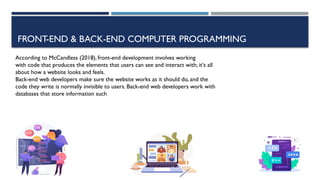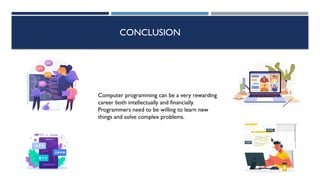Computer Programming Computer Programming Computer Programming
- 2. MAINTOPICS INTRODUCTION OF COMPUTER PROGRAMMING PROGRAMMER TOOLS TYPE OF PROGRAMMING LANGUAGES EXAMPLE PROGRAMMING LANGUAGES TYPES OF PROGRAMMING JOBS CONCLUSION
- 3. WHAT IS COMPUTER PROGRAMMING ? Programming is the process of giving machines a set of instructions that describe how a program should be carried out. Programmers will spend their whole careers learning a variety of programming languages and tools so they can effectively build computer programs.
- 4. VARIABLES, DATATYPES & SYNTAX Variables are used to store information to be referenced and manipulated in a computer program A data type is an attribute of a piece of data that tells a device how the end-user might interact with the data. Example : Integer, string, char, boolean, float Syntax is the set of rules that define what the various combinations of symbols mean.
- 5. PROGRAMMER TOOLS CODE EDITOR/IDE (VS CODE, SUBLIME TEXT, NOTEPAD++, ETC) LAPTOP/PC KNOWLEDGE & CREATIVITY
- 6. TYPE OF PROGRAMMING LANGUAGES c. Object-oriented Programming Language The aim this programming language is to think about the fault by separating it into a collection of objects that offer services which can be used to solve a specific problem. Example of the language C++, Kotlin etc. a. Procedural Programming Language Functions of procedural language may control variables, other than function‘s value returns. For example, printing out information. Example of the language Fortran, Pascal etc. b. Functional Programming Language The functional programing‘s primary focus is on the return values of functions, and side effects and different suggests that storing state are powerfully discouraged. Example of the language JavaScript python etc.
- 7. TYPE OF PROGRAMMING LANGUAGES d. Scripting Programming Language These programming languages are often procedural and may comprise object-oriented language elements, but they fall into their own category as they are Normally not full-fledged programming languages with support for development of large systems. Example of the language Perl, PHP etc. e. Logic Programming Language These types of languages let programmers make declarative statements and then allow the machine to reason about the consequences of those statements. In a sense, this language doesn‘t tells the computer how to do something, but employing restrictions on what it must consider doing. Example of the language LISP, Clojure etc.
- 8. EXAMPLE OF PROGRAMMING LANGUAGES JavaScript known for its ability to enable interactive and dynamic content and user interfaces. It supports both client-side and server-side scripting. HTML (Hypertext Markup Language) is the most basic building block of the Web. It defines the meaning and structure of web content. Cascading Style Sheets (CSS) style sheet language used for specifying the presentation and styling of a document written in a markup language such as HTML or XML
- 9. FRONT-END & BACK-END COMPUTER PROGRAMMING According to McCandless (2018), front-end development involves working with code that produces the elements that users can see and interact with; it‘s all about how a website looks and feels. Back-end web developers make sure the website works as it should do, and the code they write is normally invisible to users. Back-end web developers work with databases that store information such
- 10. TYPE OF PROGRAMMING JOBS WEB DEVELOPER These types of programmers build applications for the web. They will work with languages like HTML, CSS, JavaScript, PHP, Python, and more. MOBILE DEVELOPER These types of developers build applications for mobile devices. Programming languages will include React Native, Swift, Flutter, Java, and Kotlin. SYSTEM ENGINEER This profession combines computer science and engineering to work on complex business applications. Programming languages will include Python, Java and C++.
- 11. THE BENEFITS OF COMPUTER PROGRAMMING 1. Earn a good salary by building skills 2. Flexibility to work from anywhere, anytime 3. Creatively solve real-world problems 4. Develop cool mobile applications 5. Make addictive games that users love 6. Stay ahead of the curve by continually evolving 7. Explore artificial intelligence and other future-ready trends 8. Accomplish anything by employing technology to work for you 9. Become a mentor later 10. Coding is applicable now on almost all industries
- 12. CONCLUSION Computer programming can be a very rewarding career both intellectually and financially. Programmers need to be willing to learn new things and solve complex problems.












